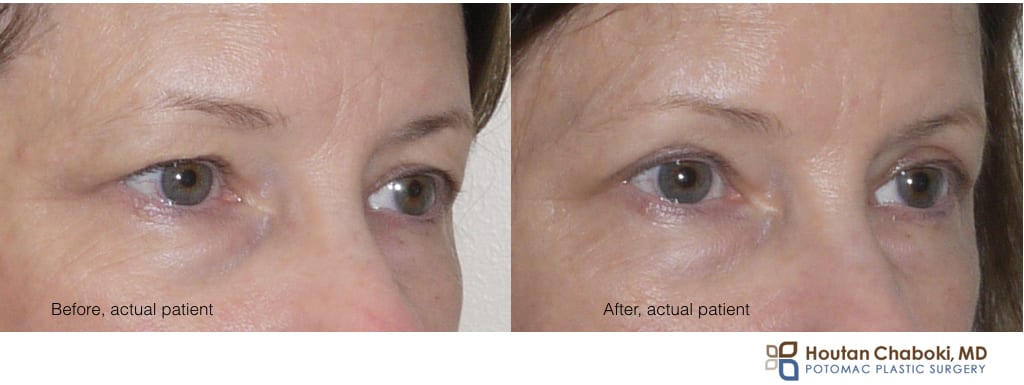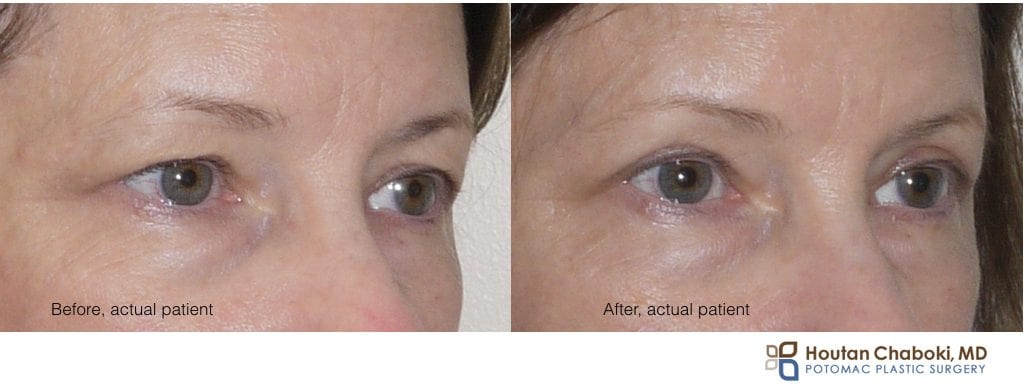
Before and after upper blepharoplasty (eyelid surgery). A conservative amount of skin, muscle, and fat was modified for a naturally, refreshed appearance. No brow lift surgery was performed.
Cosmetic surgery of the upper face and eyes is generally considered earlier as compared to the lower face. For many, the eyes show the signs of age first. Wrinkles, loose skin, excess fat, and sagging tissue may create a hooded appearance and smaller eyes. Patients often ask to remove all the excess tissue. However, plastic surgeons carefully modify the skin, muscle, and/or fat of the upper eyelid for a rejuvenated appearance.
Wrinkle relaxers, such as Botox® and Dysport®, can smooth the wrinkles around the eyes and slightly lift the brow. However, non-surgical treatments in the office don’t directly address eyelid skin, muscle, or fat. In addition, results with wrinkle relaxers are temporary, as compared to plastic surgery of the eyes.
What creates an older looking upper eyelid?
An older looking upper eyelid may have the following characteristics to varying degrees:
- excess skin
- wrinkled skin
- smaller eyes
- fatter or puffier eyes
- lower brow
- droopy eyelid
- hidden or obscured eyelashes
- ill-defined or hidden eyelid show
Upper eyelid tissue becomes excessive and droops with age, which then may crowd or narrow the eyes. The effect can make one appear older, tired, or angry. More extreme cases can also block vision.
In addition, women may complain of difficulty or inability of using makeup, such as eye shadow, eye liner, or mascara. After upper eyelid surgery, patients are more likely to apply makeup as desired.
What is upper blepharoplasty?
Upper blepharoplasty is cosmetic surgery of the upper eyelid. The primary goal of upper eyelid surgery is to “open” the eyes, not necessarily just to remove or lift tissue. After cosmetic upper eyelid surgery, more of the eye itself is visible and thus more youthful.
Upper blepharoplasty modifies the skin, muscle, and/or fat to varying degrees. Plastic surgeons will tailor the procedure for each specific patient. However, most eyelid surgery includes some skin removal.
Upper eyelid surgery can be performed in the office via local anesthesia, which we reviewed in a previous post. When combined with other cosmetic surgery, such as facelift or brow lift, then more (ex. IV or general) anesthesia may be required.
Is a brow lift required with upper eyelid surgery?
A common question among facial plastic surgery patients is whether to perform brow lift surgery at the same time as upper blepharoplasty. There isn’t a single, best answer applicable to all patients. We’ve reviewed brow vs. bleph in a prior blog post. The decision on what plastic surgery to perform is based on many factors, such as physical anatomy, patient preference, and surgeon preference.
Have you considered upper blepharoplasty? Share your questions below.


Leave a Reply